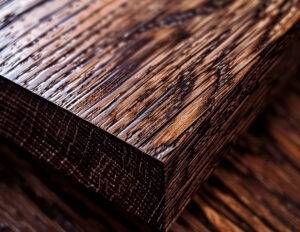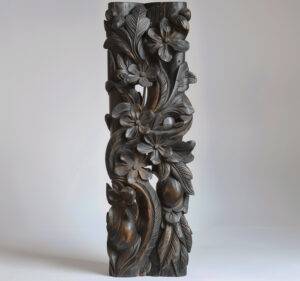Mahogany
Mahogany wood exudes elegance and comes in various shades from reddish brown to light brown, with the dark grain varying depending on its origin. It is important to look for the FSC seal, which stands for sustainable forestry, when buying mahogany.
The mahogany family, with its 50 genera and 1,400 species, includes three species of true mahogany, exclusively from South America. These trees reach enormous heights and are known for their straight, knot-free trunks. Originally native to rainforests, they are now also grown in plantations.
Mahogany wood is known for its elegant appearance with a reddish-brown colour and a shiny golden hue. Its medium-fine, even structure makes it a popular material for high-quality furniture and interior fittings. It is durable, weather-resistant and easy to work with.
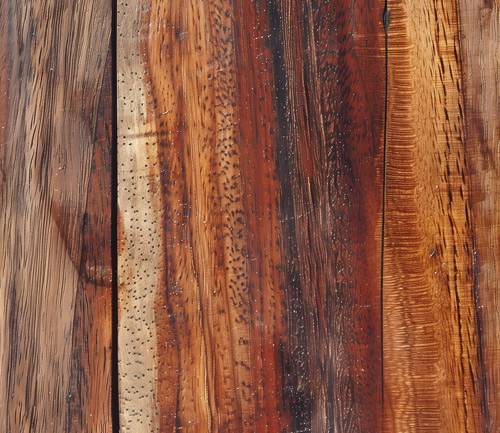
Overview of mahogany wood:
- Mahogany wood was discovered in Europe in the 18th century and quickly became a sought-after material in furniture manufacturing.
- The use of mahogany wood was a symbol of luxury and exclusivity and was often sought after by wealthy customers.
- During colonialism, mahogany wood played an important role as a commodity and was frequently extracted by exploiting the indigenous population.
- Today, the protection of mahogany trees and sustainability in furniture production is an essential issue to ensure the survival of this valuable resource.
- Modern uses of mahogany wood in furniture manufacturing include both traditional and innovative designs that utilise the beauty and durability of this material.
The discovery and spread of mahogany wood
The discovery of mahogany wood dates back to the time of European colonisation. Originally, the wood came from the tropical forests of America, particularly Central and South America as well as the Caribbean. Europeans were fascinated by the beauty of the wood and its ability to be easily worked.
With the advent of maritime trade in the 16th century, mahogany wood began to spread to Europe and other parts of the world. The wood was seen as a valuable commodity and was particularly popular with wealthy buyers.
Mahogany wood in furniture production in the 18th and 19th centuries
In the 18th and 19th centuries, the use of mahogany wood in furniture production experienced a peak in popularity. The characteristic dark colour of the wood gave the furniture an elegant appearance, while its hardness and strength ensured a long service life.
Mahogany wood was often used for high-quality furniture such as cabinets, tables and beds. It was also popular with craftsmen as it was easy to work with and provided a smooth surface.
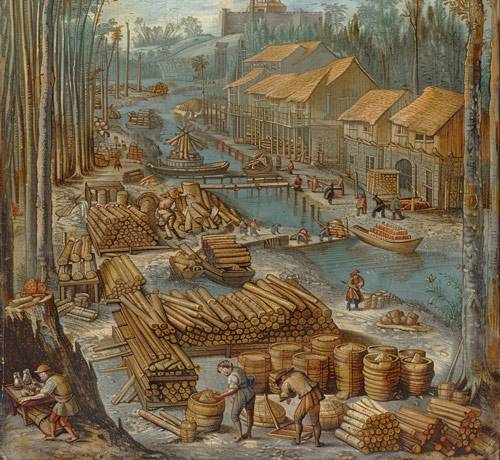
The importance of mahogany wood in colonialism
The use of mahogany wood played an important role in the age of colonialism. During the European expansion into the New World, large quantities of mahogany wood were felled and shipped to Europe.
However, the extraction of mahogany wood also had a negative impact on the indigenous population and the environment. Many indigenous communities were forced to abandon their traditional ways of life to make way for logging. In addition, excessive logging led to the destruction of large areas of tropical rainforests.
Mahogany wood as a symbol of luxury and exclusivity
Over time, mahogany wood became a symbol of luxury and exclusivity in furniture manufacturing. The rich dark colour of the wood gave the furniture a noble look, while its durability ensured that it would last for generations.
Mahogany furniture was often decorated with ornate carvings. It was frequently used in royal palaces, stately homes and other luxurious settings.
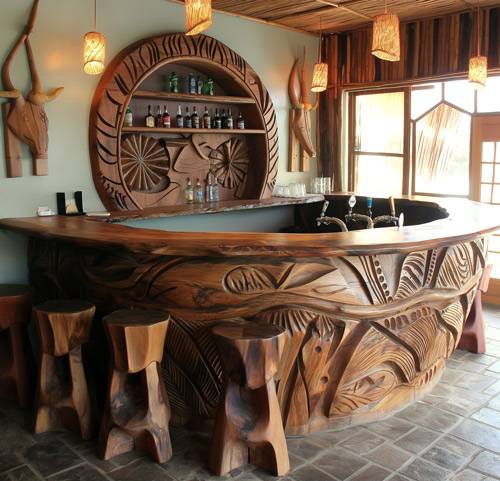
Sustainability and the protection of mahogany trees
Given the negative impact of logging on the environment, sustainability has become increasingly important in the mahogany wood industry. Efforts are being made to promote the protection of mahogany trees and develop sustainable harvesting methods.
Some countries have enacted laws to curb illegal logging and control the trade in unsustainably harvested mahogany wood. In addition, mahogany reforestation initiatives are being implemented to ensure that the wood is available for future generations.
Modern use of mahogany wood in furniture production
Today, mahogany wood is unfortunately still used too typically in furniture production. The versatility of the wood makes it possible to create a variety of styles and shapes.
Mahogany furniture is therefore available in both traditional and modern designs. The wood is regularly used for tables, chairs, beds and other pieces of furniture.
Conclusion
To summarise, mahogany wood has a long history and plays an essential role in furniture manufacturing. It is known for its beauty, durability and versatility. However, the use of mahogany wood has also had a negative impact on the environment.
It is significant that the mahogany wood industry promotes sustainable practices and ensures the protection of the trees to ensure that the wood is available in the future. With the right management, mahogany wood can continue to be a symbol of luxury and exclusivity while being a sustainable choice for high-quality furniture.
FAQs
What is mahogany wood?
Mahogany wood is a hardwood that comes from various species of trees in the Swietenia genus. It is known for its beautiful reddish-brown colour and durability.
Where does mahogany wood come from?
Mahogany wood comes mainly from Central and South America, particularly from countries such as Mexico, Honduras, Brazil and Peru.
How is mahogany wood used in furniture manufacturing?
Mahogany wood is often used in furniture manufacturing due to its durability and beauty. It is used for tables, chairs, cabinets, beds and other pieces of furniture.
What is the difference between real mahogany and other types of wood known as mahogany?
Genuine mahogany comes from the species Swietenia mahogany and Swietenia macrophylla. Other wood species labelled as mahogany may have similar characteristics, but they are not the same as genuine mahogany.
Why is mahogany wood so expensive?
Mahogany wood is highly sought after due to its durability and beauty. However, as it is protected in many countries and has limited availability, it is often expensive.
How can you make sure you are buying genuine mahogany wood?
It is important to pay attention to the origin and certification of the wood when buying mahogany wood. There are various certifications, such as FSC and PEFC, which ensure that the wood comes from sustainable sources.

